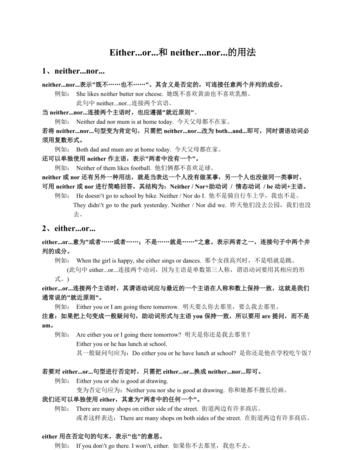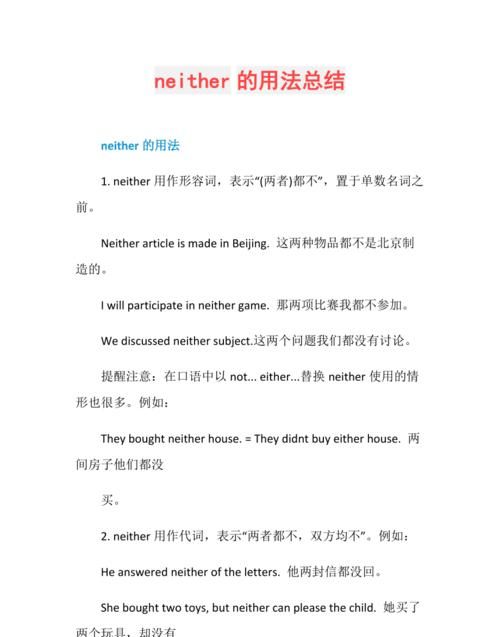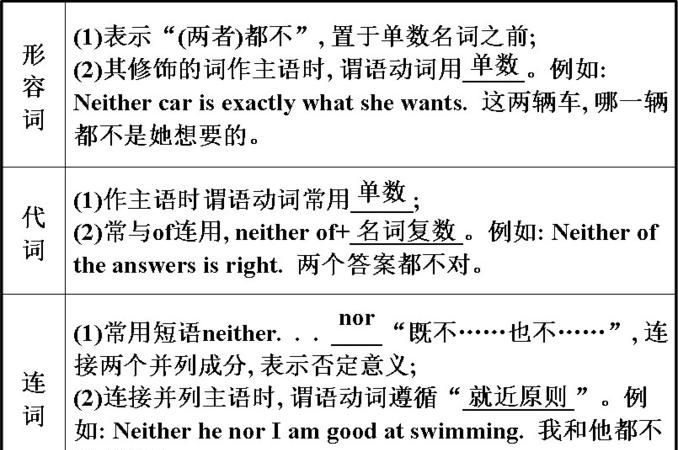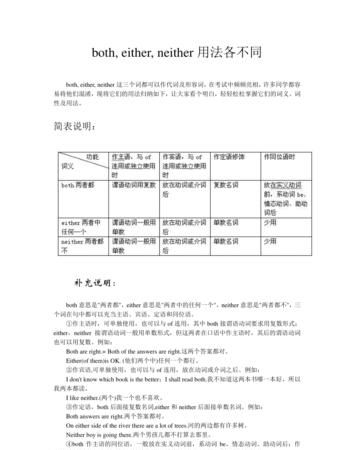本文目录
neither的用法
1. neither用作形容词,表示“(两者)都不”,置于单数名词之前。
Neither article is made in Beijing. 这两种物品都不是北京制造的。
2. neither用作代词,表示“两者都不,双方均不”。例如:
He answered neither of the letters. 他两封信都没回。
3. neither用作连词,常用短语为neither...nor...,表示“既不……也不……”。例如:
Neither he nor I am well educated. 他和我都没受过良好教育。
4. neither用作副词,作“也不”解释,放在句首,表示前面否定的内容也适用于另一个人或物,句子须采用部分倒装。此时也可用nor替换neither使用。
—I don't like this dress. 我不喜欢这件连衣裙。
—Neither / Nor do I. 我也不喜欢。

neither 用法
Neither的意思是“两个都不”(not either);either的意思是“两个中的任何一个”(one of two)或“两个中的各一个”(each of two)。
Neither常和nor用在一起;either常与or用在一起。
下面先看两个neither的例句:
Neither Mr.Li nor Mr.Zhang is in Hong Kong now.
李先生和张先生现在都不在香港。
I like neither of the novels.
这两本小说我都不喜欢。
在口语里,我们常用not either代替neither。如上面第二个句子,在口语中可以说:I don't like either of the novels.
下面是either的例句:
Either Mr.Li or Mr.Zhang is in Hong Kong now.
不是李先生就是张先生现在在香港。
We can take either road.
两条路我们可以任挑一条走。
在上面两句中,either表示one of two的意思。在下面的句子中,either作each of two和each of more than two things解:
They took seats on either side.
他们在两边就座。
Just above the platform,at either of the four corners is an exquisite female bust.
就在平台上,四个角落的每个角都有一个精致的妇女半身像。
在美国英语中,当either表示both和each的涵义时,它的动词用复数形式。例:
Either of them are enough to drive a man to distraction.
他们之中的任何一个都足以驱使一个人变得疯狂。
I do not think either of them are at home.
我认为他们两个人都不会在家。
请注意,当neither表示“亦不”涵义时,其后的主谓语往往要倒装。例:
You did not see her,neither did I.
你没有看见她,我亦未看见她。
You will not go to Macau,I neither will I.
你不想去澳门,我也不想去。
顺带一提,以上两句中的neither did I/neither will I 可说成nor did I/nor will I或and I didn't either/and I won't either.

neither 用法
1. neither用作形容词,表示“(两者)都不”,置于单数名词之前。
Neither article is made in Beijing. 这两种物品都不是北京制造的。
2. neither用作代词,表示“两者都不,双方均不”。例如:
He answered neither of the letters. 他两封信都没回。
3. neither用作连词,常用短语为neither...nor...,表示“既不……也不……”。例如:
Neither he nor I am well educated. 他和我都没受过良好教育。
4. neither用作副词,作“也不”解释,放在句首,表示前面否定的内容也适用于另一个人或物,句子须采用部分倒装。此时也可用nor替换neither使用。
—I don't like this dress. 我不喜欢这件连衣裙。
—Neither / Nor do I. 我也不喜欢。

告诉我安琪拉的用法
According to the traditional rule, neither is used only to mean “not one or the other of two.” To refer to “none of several,” none is preferred:
按传统规则,neither 只用于表示“不是这个也不是另一个”。 要指“多个中一个也没有”时最好用none :
None (not neither ) of the three opposition candidates would make a better president than the incumbent. ·
三位反对党总统候选人中的任何一个 (不用 neither )
都比在任者强。 ·
The traditional rule holds that either should be used only to refer to one of two items and that any is required when more than two items are involved:
传统规则认为either 只能用于指两者之一, 如果涉及多于两者的情况时,应用any :
Any (not either ) of the three opposition candidates still in the race would make a better president than the incumbent.
正在参加竞选的三个反对党候选人中的任何 (不是 either ) 一个都会比现任总统干得更好。
But reputable writers have often violated this rule, and in any case it applies only to the use of either as a pronoun or an adjective. When either is used as a conjunction no paraphrase with any is available, and so either is unexceptionable even when it applies to more than two clauses:
但是许多著名作家经常违反这个规则,这种情况只见于either 用作代名词或形容词时。 当either 用作连接词时, any 没有相应的替代词, 所以即使用来连接多于两个从句时,也要用either :
Either the union will make a counteroffer or the original bid will be refused by the board or the deal will go ahead as scheduled. ·
或者工会提出一个相反的建议,或者董事会拒绝原来的要价,或者这事按原计划进行。
In either . . . or constructions, the two conjunctions should be followed by parallel elements. The following is regarded as incorrect: You may either have the ring or the bracelet (properly, You may have either the ring or the bracelet ). The following is also incorrect: She can take either the examination offered to all applicants or ask for a personal interview (properly, She can either take . . . ). · When used as a pronoun, either is singular and takes a singular verb: The two left-wing parties disagree with each other more than either does (not do ) with the right. When followed by of and a plural noun, either is often used with a plural verb:
在either … or 结构中, 两个连接词后应跟并列成分。下面这句话被认为是不正确的:You may either have the ring or the bracelet ,正确的应是 You may have either the ring or the bracelet (你既可以有戒指也可以有手镯) 下面这句也是不对的:She can take either the examination offered to all applicants or ask for a personal interview。 正确的应是, She can either take …(她可以参加提供给所有申请人的考试,也可以要求一个单独面试。) 作为代名词时,either 是单数,动词应用单数形式: The two left-wing parties disagree with each other more than either does (不用 do ) with the right.(两个左翼党之间的分歧比任何一个与右翼党的分歧都要大) 当后面接of 和一个复数名词的时候, either 经常与动词复数形式配合:
Either of the parties have enough support to form a government.
这些政党中任一个都有足够的支持来组阁一个政府。
But this usage is widely regarded as incorrect; in an earlier survey it was rejected by 92 percent of the Usage Panel. · When all the elements in an either . . . or construction (or a neither . . . nor construction) used as the subject of a sentence are singular, the verb is singular:
但是这种用法通常被认为是不正确的,在以前的调查中它被用法使用小组百分之九十二的成员所否定。当作为句中主语的either…or 结构(或 neither…nor 结构)中的所有成分都是单数的时候, 动词也应用单数:
Either Eve or Herb has been invited.
伊夫和赫伯都被 邀请了。
Analogously, when all the elements in the either . . . or construction are plural, the verb is plural too:
类似地,当所有either…or 结构中的成分都是复数的时候, 动词也应用复数:
Either the Clarks or the Kays have been invited.
克拉克全家和凯全家都被 邀请了。
When the construction mixes singular and plural elements, however, there is some confusion as to which form the verb should take. It has sometimes been suggested that the verb should agree with whichever noun phrase is closest to it; thus one would write Either Eve or the Kays have been invited, but Either the Kays or Eve has been invited. This pattern is accepted by 54 percent of the Usage Panel. Others have maintained that the construction is fundamentally inconsistent whichever number is assigned to the verb and that such sentences should be rewritten accordingly. As Wilson Follett put it:
然而,当结构中既有单数又有复数成分的时候,动词应采取什么形式说法不定。人们有时建议动词的人称和数应与离得最近的名词短语呼应;因此人们说Either Eve or the Kays have been invited , 而不是Either the Kays or Eve has been invited 。 这种格式被用法使用小组54的成员所接受。也有人认为不管动词用什么样的数, 这个结构本质上都是一致的,因此这样的句子应重写。象威尔逊·伏莱特所说的:
“This [construction] is defensible, but a workmanlike writer may put his pride in not writing sentences that need defending.”See Usage Note at every, neither, or 1
“这个是站得住脚的,但是精心推敲的作者应以写出不需为之辩护的句子而感到骄傲。”参见 every, neither, or1
The traditional rule also holds that neither is grammatically singular:
传统规则还认为neither 在语法上是单数:
Neither candidate is having an easy time with the press.
每一位候选人都被记者百般纠缠。
However, it is often used with a plural verb, especially when followed by of and a plural:
但它常跟复数动词连用,尤其当后跟of 和一个复数名词时:
Neither of the candidates are really expressing their own views. ·
没有一位候选人真实地表达出他们的观点。 ·
As a conjunction neither is properly followed by nor, not or, in formal style:
作为一个连词,在正式文体中neither 后宜跟 nor 而不是 or :
Neither prayers nor curses (not or curses ) did any good. See Usage Note at either, every, he 1none, nor 1or 1
祈祷和咒语(而不用 or curses ) 都不会起任何作用 参见 either, every, he1none, nor1or1

以上就是关于neither用法归纳 ,neither的用法的全部内容,以及neither用法归纳 的相关内容,希望能够帮到您。
